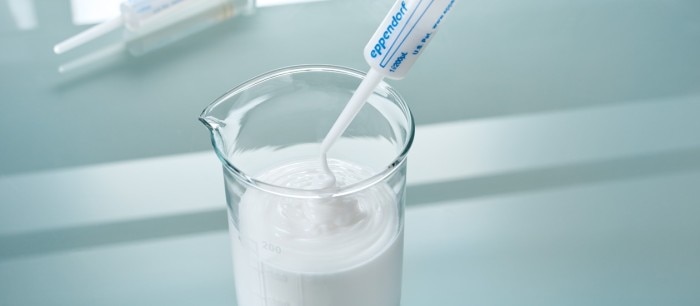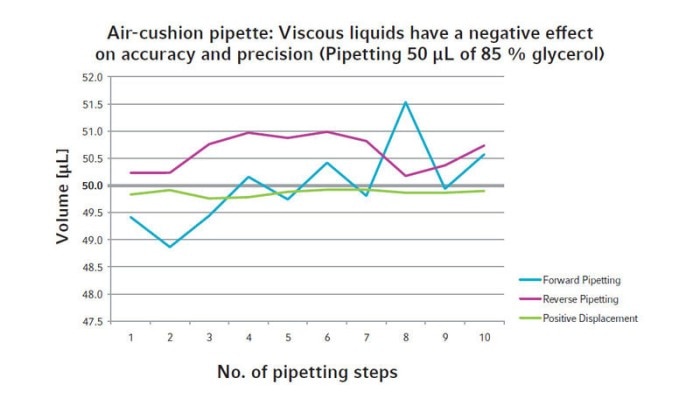菜单
CN | CNY
登录身份:
CN | CNY

Viscous Liquids Need Special Pipetting Techniques
实验室学院
- 移液与分液
- 文章
Do you cut off the pipette tip when pipetting glycerol? I did during my PhD, but I had to learn that this increases inaccuracy and imprecision of my pipetting. And to be honest when I cut the tip, I could have also directly poured the glycerol from the bottle into the tube. So I changed my technique to improve pipetting results and gain more reliable and reproducible results when working with viscous liquids.
A liquid category which needs special attention when pipetting are viscous liquids. These are often used in the lab, either in a pure form or as buffer components. Famous representatives of viscous liquids in research laboratories are glycerol, Triton X-100 and Tween® 20. But also, laboratories doing quality control of foods, cosmetics, pharmaceuticals and other consumer products deal with viscous solutions on a daily basis.
Viscosity is either stated as dynamic, or kinematic viscosity. In this article I concentrate on the dynamic viscosity of liquids since it describes the movement of the liquid. The degree of viscosity is specified in millipascal per second (mPa*s). Rather fluid samples around 200 mPa*s such as 85 % glycerol can still be transferred using a classic air-cushion pipette. When applying a special technique, reverse pipetting, aspiration of air bubbles or residues in the tip are highly reduced and leads to more accurate pipetting results. But still, it is not the best we can do to improve pipetting of viscous liquids (see fig. 1).
When viscosity increases, difficulties increase. Medium viscous solutions up to 1,000 mPa*s are more difficult to be transferred using classic air-cushion pipettes. Due to the high inner friction of molecules, viscous liquids have a very slow flow behavior and pipetting must be done very slowly and carefully. Reverse Pipetting technique is often not enough for accurate liquid transfer and many people weigh their samples. This strategy also means taking the density of the liquid into account as well as the laboratory conditions such as humidity and temperature to accurately calculate the needed liquid volume in weight. Therefore, other pipetting tools, so called positive displacement tools, are recommended. These have a tip with an integrated piston, just like a syringe. Hence, liquid can be more easily aspirated and dispensed while accurate liquid transfer is given. A special technique is not necessary.
Nevertheless, also positive displacement tools reach a limit with very viscous solutions such as liquid honey, skin cream or certain mechanical oils. These very demanding liquids need another special tool that also uses the positive displacement principle but additionally has an optimized design to deal with highly viscous solutions. This special tool has been compared to existing positive displacement tips to gain a threshold at which it is important to switch from a normal dispensing tip to a special tip for highly viscous solutions. It was shown that accuracy is increased and forces needed for aspiration and dispensing are reduced when using a special tip for highly viscous liquids. For further detailed information and liquid examples, please download Applicaton Note 376 on optimized performance for highly viscous liquids.
Viscosity is either stated as dynamic, or kinematic viscosity. In this article I concentrate on the dynamic viscosity of liquids since it describes the movement of the liquid. The degree of viscosity is specified in millipascal per second (mPa*s). Rather fluid samples around 200 mPa*s such as 85 % glycerol can still be transferred using a classic air-cushion pipette. When applying a special technique, reverse pipetting, aspiration of air bubbles or residues in the tip are highly reduced and leads to more accurate pipetting results. But still, it is not the best we can do to improve pipetting of viscous liquids (see fig. 1).
When viscosity increases, difficulties increase. Medium viscous solutions up to 1,000 mPa*s are more difficult to be transferred using classic air-cushion pipettes. Due to the high inner friction of molecules, viscous liquids have a very slow flow behavior and pipetting must be done very slowly and carefully. Reverse Pipetting technique is often not enough for accurate liquid transfer and many people weigh their samples. This strategy also means taking the density of the liquid into account as well as the laboratory conditions such as humidity and temperature to accurately calculate the needed liquid volume in weight. Therefore, other pipetting tools, so called positive displacement tools, are recommended. These have a tip with an integrated piston, just like a syringe. Hence, liquid can be more easily aspirated and dispensed while accurate liquid transfer is given. A special technique is not necessary.
Nevertheless, also positive displacement tools reach a limit with very viscous solutions such as liquid honey, skin cream or certain mechanical oils. These very demanding liquids need another special tool that also uses the positive displacement principle but additionally has an optimized design to deal with highly viscous solutions. This special tool has been compared to existing positive displacement tips to gain a threshold at which it is important to switch from a normal dispensing tip to a special tip for highly viscous solutions. It was shown that accuracy is increased and forces needed for aspiration and dispensing are reduced when using a special tip for highly viscous liquids. For further detailed information and liquid examples, please download Applicaton Note 376 on optimized performance for highly viscous liquids.
显示更少

Figure 1: Comparison of forward and reverse pipetting technique using air-cushion pipettes, as well as multi-dispensing using positive displacement dispenser. Positive displacement is the most accurate pipetting option for viscous liquids.

